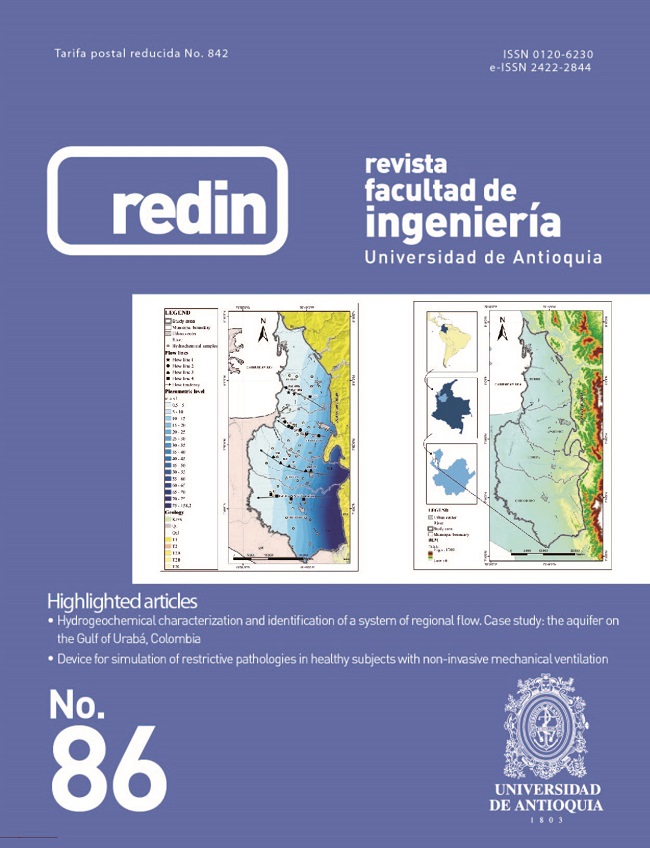Estudio de propiedades ópticas no lineales en el aceite lubricante de automóviles a través de la técnica Z-Scan
DOI:
https://doi.org/10.17533/udea.redin.n86a04Palabras clave:
aceite lubricante, potencia, susceptibilidad, Z-scanResumen
Se determinaron las propiedades ópticas no lineales en función de la potencia del láser para el aceite multígrado 20W-50 para motores. Estas fueron obtenidas empleando la técnica Z-scan por transmisión en configuraciones de celda cerrada y abierta. Se utilizó un láser de Nd:YAG operando en modo de onda continua (CW), emitiendo en 532 nm y regulado en corriente. Para el control de la técnica se implementó una interfaz en LabVIEW que permite monitorear en tiempo real el desarrollo de la medida. Se estimaron valores del coeficiente de absorción no lineal (β), del índice de refracción no lineal (η2) y de la susceptibilidad eléctrica de tercer orden (|χ (3)|), encontrándose ordenes de magnitud de 10−3 cm/W, 10−9 cm2 /W y 10−5 esu respectivamente. Estos resultados muestran que el aceite lubricante para automóvil tiene propiedades ópticas no lineales significativas.
Descargas
Citas
P.A. Franken, A. E. Hill, C.W. Peters, and G.Weinreich, ”Generation of Optical Harmonics,” Phys. Rev. Lett., vol. 7, no. 4, pp. 118-120, 1961.
R.W. Terhune, P. D. Maker, and C. M. Savage, ”Optical Harmonic Generation in Calcite,” Phys. Rev. Lett., vol. 8, no. 10, pp. 404-406, 1962.
N. Bloembergen, ”Nonlinear optics and spectroscopy,” Rev. Mod. Phys., vol. 54, no. 3, pp.685-695, 1982.
X. Yan, Z. Liu, X. Zhang, W. Zhou, and J. Tian, ”Polarization dependece of Z-scan measurement: theory and experiment,” Optics Express, vol. 17, no. 8, pp. 6397-6406, 2009.
M. Sheik, A.A Dijo, T. H. Wei, D.J Hagan, and E. Van, ”Sensitive measurement of optical nonlinearities using a single beam,” IEEE Journal of Quantum Electronics, vol. 26, no. 4, pp.760-769, 1990.
S. Pramodini, Y. N. Sudhakar, M. SelvaKumar, and P. Poornesh, ”Studies on third-order optical nonlinearity and power limiting of conducting polymers using the z-scan technique for nonlinear optical applications,” Laser Physics, vol. 24, no. 4, pp. 1-7, 2014.
A. Granmayeh, ”Single Beam Z-scan Measurement of Nonlinear Refractive Index of Crude Oils,” Journal of Modern Physics, vol. 5, no. 5, pp. 280-284, 2014.
S. Agudelo y D. A. Hernández, ”sistema de recolección de aceites residuales para estaciones de servicio y servitecas, contribuyendo con el cuidado y la preservación del medio amambiente,” Undergraduate thesis, Universidad EAFIT, Medellín, Colombia, 2006.
Y. Suzaki and A. Tachibana, ”Measurement of the μm sized radius of Gaussian laser beam using the scanning knife-edge,” Applied Optics, vol. 14, no. 12, pp. 2809-2810, 1975.
R. W. Boyd, Nonlinear Optics, 3rd ed. New York, USA: Academic Press, 2008.
C. Cueto, A. Pérez, and F. Racedo, ”Characterization of the nonlinear optical properties of the new 2-amino-4, 6- difenilnicotinonitrilo by UV-Vis spectroscopy absorption and Z-scan,” Journal of Physics: Conference Series, vol. 786, no. 1, pp. 1-6, 2017.
K. Rodriguez, A. Pérez, and F. Racedo, ”Characterization of the optical nonlinear response of the (E)-4-(4-dimetylaminophenyl) but-3-en-2-one and (E) 4-(4- nitrophenyl) but-3-en-2-one by Z-scan,” Journal of Physics: Conference Series, vol. 786, no. 1, pp. 1-7, 2017.
A. García, S.Valbuena, R. Sarmiento, y F. Racedo, ”Medida de las propiedades ópticas no-lineales del aceite de oliva usando Z-Scan,” Optica pura y aplicada, vol. 48, no. 1, pp. 55-61, 2015.
Descargas
Publicado
Cómo citar
Número
Sección
Licencia
Derechos de autor 2018 Revista Facultad de Ingeniería Universidad de Antioquia

Esta obra está bajo una licencia internacional Creative Commons Atribución-NoComercial-CompartirIgual 4.0.
Los artículos disponibles en la Revista Facultad de Ingeniería, Universidad de Antioquia están bajo la licencia Creative Commons Attribution BY-NC-SA 4.0.
Eres libre de:
Compartir — copiar y redistribuir el material en cualquier medio o formato
Adaptar : remezclar, transformar y construir sobre el material.
Bajo los siguientes términos:
Reconocimiento : debe otorgar el crédito correspondiente , proporcionar un enlace a la licencia e indicar si se realizaron cambios . Puede hacerlo de cualquier manera razonable, pero no de ninguna manera que sugiera que el licenciante lo respalda a usted o su uso.
No comercial : no puede utilizar el material con fines comerciales .
Compartir igual : si remezcla, transforma o construye a partir del material, debe distribuir sus contribuciones bajo la misma licencia que el original.
El material publicado por la revista puede ser distribuido, copiado y exhibido por terceros si se dan los respectivos créditos a la revista, sin ningún costo. No se puede obtener ningún beneficio comercial y las obras derivadas tienen que estar bajo los mismos términos de licencia que el trabajo original.










 Twitter
Twitter